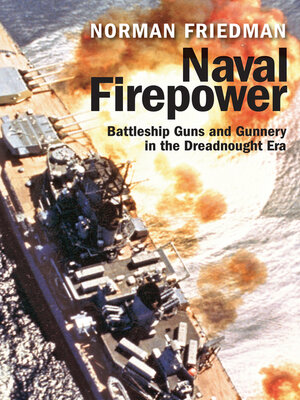
Sign up to save your library
With an OverDrive account, you can save your favorite libraries for at-a-glance information about availability. Find out more about OverDrive accounts.
Find this title in Libby, the library reading app by OverDrive.



Search for a digital library with this title
Title found at these libraries:
| Library Name | Distance |
|---|---|
| Loading... |
An in-depth history of naval battleship firepower from before World War I to the end of World War II, by America’s leading naval analyst.
For more than half a century, the big gun was the arbiter of naval power, but it was useless if it could not hit the target fast and hard enough to prevent the enemy doing the same. Because the naval gun platform was itself in motion, finding a “firing solution” was a significant problem exacerbated when gun sizes increased, fighting ranges lengthened, and seemingly minor issues like wind velocity had to be considered. To speed up the process and eliminate human error, navies sought a reliable mechanical calculation.
This heavily illustrated book outlines for the first time in layman’s terms the complex subject of fire-control, as it dominated battleship and cruiser design from before World War I to the end of the dreadnought era. Covering the directors, range-finders, and electro-mechanical computers invented to solve the problems, author Norman Friedman explains not only how the technology shaped (and was shaped by) the tactics involved, but also analyzes their effectiveness in battle. His examination of the controversy surrounding Jutland and the relative merits of competing fire-control systems draws surprising conclusions. He also reassesses many other major gun actions, such as the battles between the Royal Navy and the Bismarck, and the U.S. Navy actions in the Solomons and at Surigao Strait. All major navies are covered, and the story concludes at the end of World War II with the impact of radar.
For more than half a century, the big gun was the arbiter of naval power, but it was useless if it could not hit the target fast and hard enough to prevent the enemy doing the same. Because the naval gun platform was itself in motion, finding a “firing solution” was a significant problem exacerbated when gun sizes increased, fighting ranges lengthened, and seemingly minor issues like wind velocity had to be considered. To speed up the process and eliminate human error, navies sought a reliable mechanical calculation.
This heavily illustrated book outlines for the first time in layman’s terms the complex subject of fire-control, as it dominated battleship and cruiser design from before World War I to the end of the dreadnought era. Covering the directors, range-finders, and electro-mechanical computers invented to solve the problems, author Norman Friedman explains not only how the technology shaped (and was shaped by) the tactics involved, but also analyzes their effectiveness in battle. His examination of the controversy surrounding Jutland and the relative merits of competing fire-control systems draws surprising conclusions. He also reassesses many other major gun actions, such as the battles between the Royal Navy and the Bismarck, and the U.S. Navy actions in the Solomons and at Surigao Strait. All major navies are covered, and the story concludes at the end of World War II with the impact of radar.







